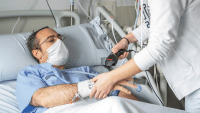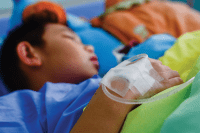Immersion, simulation, and adaptation result in a successful program for nursing students.
- Early introduction to oncology nursing should be included in nursing school curricula.
- Adapting a hybrid format for student orientation can prove beneficial to all stakeholders.
- Cancer care includes complex communication, and nurses require skills training equipped help them have these conversations with patients.
It’s been over 4 years since COVID-19 began triggering substantial changes in social norms and healthcare systems worldwide. As a result, healthcare organizations have modified and adapted their educational practices. The staff at a Magnet®-recognized National Comprehensive Cancer Institute continues to leverage lessons learned during the pandemic to advance oncology nursing. One education modification included restructuring the onboarding process within our clinical assistant program (CAP).
History
In response to the nursing shortage of the 1980s, the cancer center launched CAP. In addition to introducing nursing students to the oncology specialty, the program also offered them the opportunity to apply theoretical knowledge and strengthen their nursing skills. The organization offered the paid internship to senior nursing students. The first cohort, in June 1981, included six students from schools in the New York City area.
Oncology nursing core competencies
Genetics in the clinical setting
The informal recruitment process relied on word of mouth and walk-ins. The director of nurse recruitment interviewed potential candidates on-site with offers made within a week.
The program ran for 6 weeks, with 4 classroom days for orientation. Content included ID card processing; a building tour; mandatory training videos (age-specific, body mechanics); a cancer concepts overview with treatment and symptom management; policies and procedures with a focus on patient care activities (such as taking vital signs and weights, administering cleansing enemas, and measuring and recording intake and output); post-mortem care; instruction in setting up admission, discharge, and postoperative units; infection control; dress code; attendance; and the related job description. The program placed students on med-surg units and paired them with nursing assistants as preceptors under the supervision of an RN. They gained experiential learning through observation of RN bedside care.
Students received a certificate of completion at the end of the program and offered the option to work per diem as nursing assistants. One of the inaugural CAPs, a co-author of this article and a graduate of Hunter College, was the only student in this cohort who selected oncology as a specialty after graduation. She has worked at the cancer center for over 40 years. (See Oncology and nursing school curricula.)
Oncology and nursing school curricula
The Centers for Disease Control and Prevention reports that cancer is the second leading cause of death after heart disease. In 2005, the Institutes of Medicine recommended that healthcare providers receive education in caring for cancer patients. Fox, reflecting on his time as a nursing instructor, noted that students and new nurses frequently encounter patients diagnosed with cancer early in their careers; however, Hotchkiss and colleagues concluded that nursing schools don’t offer substantial oncology instruction within their curriculum. Fox recommended increasing the oncology content in nursing undergraduate curricula to inspire interest in the specialty and improve the ability of new nurses to care for patients with cancer.
Adjusting to the pandemic
Despite challenges experienced throughout CAP’s existence, the program has continued annually with modifications in both the classroom and clinical setting. The program now runs for 10 weeks and remains competitive across the country. In addition, the number of students accepted into the program has increased.
As with much of nursing education, we had to adjust CAP, which originally was offered only in-person, to accommodate changes required as a result of the pandemic. This shift in practice, in addition to the constraints on nursing personnel in the patient care environment, mandated that nurse educators and other stakeholders strategize to ensure a safe transition for students into the clinical setting. Ultimately, CAP continued during the pandemic to facilitate the ongoing introduction of oncology nursing to students and possible recruitment upon graduation.
Transitioning away from traditional in-person to remote learning has paved the way for hybrid learning in our CAP onboarding process. Brainstorming among team members and other stakeholders in this new landscape led to the acceptance of previously rejected creative teaching methodologies.
The organization remained committed to offering the program to senior nursing students during the pandemic, especially when nursing schools struggled to find organizations where students could complete clinical rotations. Ultimately, adaptation of the hybrid learning platform, including online and in-person formats for orientation, facilitated the continuation of CAP.
CAP format modifications
Initially, the program began with intensive classroom instruction on the foundational knowledge of cancer as well as policies and procedures to guide patient care through diagnosis, treatment, and survivorship. Students also received hands-on computer training for documentation. In addition, they participated in experiential learning opportunities at the unit level in the care of patients with cancer. These opportunities helped students develop invaluable skills to enhance their transition into their new role as nurses.
Students are assigned to acute care and ambulatory settings and work the same shifts as their assigned preceptors. CAPs also can rotate off their home unit for a broader view of cancer care.
During the pandemic, students attended classroom orientation remotely and participated in online learning games to reinforce cancer care concepts. They also took an online summative exam to assess learning outcomes. Participation in the program’s clinical component required students to present evidence of COVID-19 vaccination and receive respirator fit testing before reporting to their assigned units. Offering clinical rotations with these restrictions allowed students to connect personally, share stories, and engage in patient care activities.
Communication skills training
In 2015, we received a philanthropic contribution that enables us to provide students with communication skills training related to complex and challenging patient care issues. The Communication Skills Training and Research Program teaches students effective communication with patients and their families to enhance patient-centered care as they cope with a cancer diagnosis. The interactive program uses small group role play related to responding empathically to patients, discussing death and dying and end-of-life care goals, and managing difficult interactions with families.
Immersion and simulation
In 2022, the program included educational activities in our immersion room and enhanced clinical scene investigation in our simulation lab. Topics included obtaining a virtual handoff, performing patient assessments, recognizing patient safety issues, intervening when patients begin to decompensate, placing ECG leads, and identifying the appropriate products and steps necessary to prevent skin breakdown in patients with cancer.
Cancer care for advanced disease prevention and progression involves surgery, chemotherapy, and radiation therapy. To address this potential knowledge gap, the organization decided to invite students to rotate for one day through the operating room as an introduction to oncology nursing in this setting. (See Student feedback.)
Communication skills feedback
- “This was an eye opener to me on how I need to brush up on how to respond to specific topics.”
- “This one module (on Death, Dying, and End of Life Goals of Care) helped me a lot.”
- “I have learned a lot of strategies and communication techniques from this course that will be helpful in a clinical setting.”
- “Thought it was very helpful, engaging, and informative on topics that can be hard/stressful for nursing students due to little exposure.”
- “I enjoyed this module (Death, Dying, and End of Life Goals of Care) the most because it is the hardest of the conversations, in my opinion.”
- “Death and dying is the worst part of this career, and it is never going to be an easy conversation to have.”
- “I am grateful this module is included so if/when the time comes where I may have this conversation, I am not overwhelmed or freeze when I should be caring for the patient and their needs.”
Operating room feedback
- “The experience was informational, inclusive, and extremely interesting in what a day as an OR nurse looks like.”
- “Collaborative since everyone works together to maintain patient safety.”
- “It was very interesting to see that side of nursing.”
- “I thoroughly enjoyed the OR experience!”
- “Amazing! It was an incredible experience.”
- “We are all so lucky to have experienced this.”
- “I found this extremely beneficial and a great learning experience.”
- “I would recommend doing this for future CAPs.”
Overall feedback
- “Better than simulation.”
- “We will be working with these patients when we graduate.”
- “Personal protective equipment was readily available.”
- “Thanks for the opportunity.”
Program conclusion
In 2022, at the end-of-program pinning ceremony, the organization celebrated and recognized the 51 participating students, who were selected from an initial pool of over 500 applicants. Some students opted to continue working as unlicensed assistive personnel during school breaks to provide patient care. This opportunity improved their chances of securing a position with the organization after graduation and successfully passing the NCLEX exam. (See CAP hires.)
Provide a spark
Nursing oncology aims to promote early detection, decrease risk, and assist in the management of care, symptoms, and treatment side effects. To continue sparking student interest in oncology nursing, we’ll strengthen our CAP by incorporating multiple modalities (including technology-based activities) for teaching, learning, and practice.
The authors are nursing professional development specialists at a National Comprehensive Cancer Institute in New York City, New York.
References
Centers for Disease Control and Prevention. Leading Causes of Death. January 17, 2024. cdc.gov/nchs/fastats/leading-causes-of-death.htm
Dietmann ME. Nurse faculty beliefs and teaching practices for the care of the cancer survivor in undergraduate nursing curricula. J Cancer Educ. 2017;32(4):764-70. doi:10.1007/s13187-016-1074-6
Edwards D, Anstey S, Kelly D, Hopkinson J. An innovation in curriculum content and delivery of cancer education within undergraduate nurse training in the UK. What impact does this have on the knowledge, attitudes, and confidence in delivering cancer care? Eur J Oncol Nurs. 2016;21:8-6. doi:10.1016/j.ejon.2015.12.003
Fox C. Why our undergraduate nursing programs need oncology content: Reflections of a nursing instructor. Can Oncol Nurs J. 2020;30(1):62-3
Hotchkiss J, Bula AK, Zimba C, et al. Evaluating the knowledge change before and after continuing cancer education in Malawian nurses. J Cancer Educ. 2023:1-5. doi:10.1007/s13187-023-02310-y
Oncology Nursing Society. ONS essential competencies and curriculum for undergraduate/pre-licensure nursing program. ons.org/ons-undergrad-pre-licensure-core-competencies
Rosenzweig M, Nugent B, Belcher SM, Welsch A, Aitken L. When the patient has cancer: Effective nurse communication in the non-oncology setting about neutropenic fever. Medsurg Nurs. 2019;28(3):157-62.
Siegel RL, Miller KD, Wagle NS, Jemal A. Cancer statistics, 2023. CA Cancer J Clin. 2023;73(1):17-48. doi:10.3322/caac.21763
Keywords: clinical assistant, COVID-19, nursing students, oncology nursing, onboarding



















